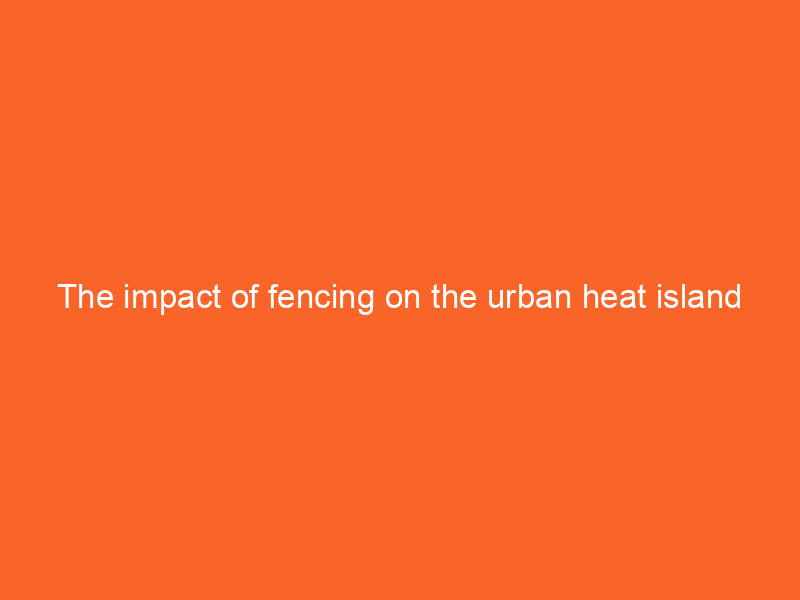Mitigating Urban Heat with Fencing: A Sustainable Approach by TimberLandry
The impact of fencing on the urban heat island effect
At TimberLandry, we understand the importance of considering the broader environmental impact of fencing solutions. This comprehensive blog delves into the intricate relationship between fencing choices and the urban heat island (UHI) effect, shedding light on sustainable practices for a cooler, greener urban landscape.
Introduction: Unveiling the Urban Heat Island Effect
The effect of urban heat islands occurs when metropolitan regions have higher temperatures than rural ones. Concrete asphalt and various other heat-absorbing materials all contribute to this problem. But did you know that your choice of fencing material can also play a role?
Understanding Fencing’s Role in UHI: The Thermal Mass Factor
Fencing materials with high thermal mass, such as concrete or metal, can absorb and retain heat, exacerbating the UHI effect. TimberLandry advocates for sustainable alternatives like wooden fencing. Wood has lower thermal mass, reducing heat absorption and contributing positively to the urban microclimate.
Cooling Strategies: Vegetative Fencing Solutions
TimberLandry encourages environmentally conscious fencing options, including living or vegetative fences. Planting climbing vines or installing green walls enhances aesthetics and promotes natural cooling through shade and transpiration.
Reflective Fencing: A Smart Choice for Urban Coolness
Reflective surfaces play a crucial role in mitigating the UHI effect. TimberLandry recommends using reflective coatings on fencing materials. This approach helps bounce sunlight back into the atmosphere, reducing heat absorption and creating a cooler urban environment.
Smart Designs for Enhanced Airflow
Incorporating design elements that facilitate airflow is another strategy to combat urban heat. TimberLandry suggests fences with gaps, lattice patterns, or slatted designs. These features encourage better air circulation, minimizing heat buildup and promoting a more comfortable atmosphere.
Local Case Studies: TimberLandry’s Sustainable Fencing Solutions
Explore how TimberLandry has implemented sustainable fencing solutions in various urban projects across the UK. From eco-friendly wood choices to innovative designs, our projects showcase the potential to create aesthetically pleasing environments while combating the UHI effect.
Community Impact: Fostering Green Practices
TimberLandry believes in fostering a sense of community and environmental responsibility. Our blog explores how collective efforts in choosing sustainable fencing can contribute to broader initiatives to reduce the UHI effect and create healthier urban spaces.
Conclusion: TimberLandry’s Commitment to Sustainable Urban Living
In conclusion, TimberLandry emphasizes making informed choices regarding fencing materials and designs. By opting for sustainable solutions, you enhance the aesthetics of your surroundings and actively contribute to mitigating the urban heat island effect and fostering a greener, cooler urban environment. Choose TimberLandry for a sustainable and stylish approach to fencing solutions.
FAQs
1: How does fencing contribute to the urban heat island effect?
Fencing materials with high thermal mass, like concrete or metal, can absorb and retain heat, contributing to elevated temperatures in urban areas. TimberLandry recommends choosing materials with lower thermal mass, such as wood, which helps reduce the heat island effect.
2: What are the benefits of vegetative fencing in combating urban heat?
Vegetative fencing, such as living fences, provides natural shade and promotes transpiration, contributing to a cooler microclimate. TimberLandry encourages these eco-friendly alternatives for their aesthetic appeal and cooling properties.
3: How does reflective fencing help in mitigating urban heat?
Reflective coatings on fencing materials bounce sunlight back into the atmosphere, preventing excessive heat absorption. TimberLandry suggests using reflective surfaces to create a cooler urban environment and reduce the overall impact of the urban heat island effect.
4: Can fencing design influence urban cooling?
Certain fencing designs can enhance airflow and minimize heat buildup. TimberLandry recommends fences with gaps, lattice patterns, or slatted designs to facilitate better air circulation, creating a more comfortable and cooler urban atmosphere.

